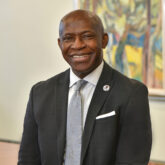Johnson!
Hart!
Seneca!
Riggs!
The chants become boisterous and palpable. It’s the opening Welcoming Torchlight Ceremony in the Marano Campus Center, and nervous newcomers have quickly become unified by chanting the names of residence halls. These are the members of the Class of 2019, abuzz with excitement. They have just begun to define their sense of place among hundreds of peers who have gathered to begin their SUNY Oswego journey.
They are capturing the moment on cell phones. They are posting it to Facebook, Instagram and Snapchat.
Technology use reflects the day-to-day life of millennials, and at the same time it has fused with a long-standing tradition of a college education: Life in a residence hall.
 In fact, college residence halls have mirrored shifting educational, social, political, moral and technological standards through the decades, and for this youngest group of students, it is no different. While technology may be a defining part of their collective identity, they have responded to the residential campus experience in much the same way as those who have lived in SUNY Oswego’s halls before them—with a sense of community and pride.
In fact, college residence halls have mirrored shifting educational, social, political, moral and technological standards through the decades, and for this youngest group of students, it is no different. While technology may be a defining part of their collective identity, they have responded to the residential campus experience in much the same way as those who have lived in SUNY Oswego’s halls before them—with a sense of community and pride.
“What you bring to the world is the result of what you’ve synthesized from immersing yourself in your environment,” President Deborah F. Stanley said during the Fall 2015 School of Business Symposium. While “everything is infused with technology,” technology cannot replace the robust face-to-face interaction that occurs within the physical classroom and the physical campus.
“College is an immersion experience,” said Richard Kolenda, assistant vice president for residence life and housing at SUNY Oswego. “It’s the entire package. It’s not just classes. Residence hall life is often what people remember most; the sense of connection to other students and the campus.”
Experience the Sense of Place: Multimedia Presentation
About 4,300 students—around 1,500 of them freshmen—live on the SUNY Oswego campus, in 13 residence halls and 68 townhome units. According to Kolenda, today’s residents come from 22 states and 16 countries.
“Although I did not know it then, it was a preview of life ahead and a wonderful playground for exploration, building relationships, resolving conflict, celebrating accomplishments and professional growth,” said Ron Kurtz ’82, who served as a resident adviser in Oneida Hall for three years and today is financial controller for Shyft Analytics in Boston. “I value my lessons from living on campus. Professionally, it has paid off in career growth. As a person, it has made me a happy man.”
No longer can you find residences in the form of barracks parked along the bluffs overlooking the lake. Gone are some of the residence halls that former students may have known well: Kingsford, Pathfinder and Farnham, to name a few. Today’s residence halls are contemporary, renovated and devoid of the stark cinderblock walls that past students remember not-so-fondly for their inability to pierce with thumbtacks to hang Elvis Presley, and eventually Led Zeppelin posters. But while decor, architecture and musical tastes may have changed, the benefits of life in a building full of diverse peers has not.
 “I lived in an Irish Catholic neighborhood growing up,” said Kevin Moran ’87, who is now executive sports editor for The Troy Record/Saratogian newspaper in Troy, N.Y. “I never met an African-American from Brooklyn or a Jewish kid from Long Island until I moved into Cayuga Hall. I experienced diversity and new cultures for the first time.”
“I lived in an Irish Catholic neighborhood growing up,” said Kevin Moran ’87, who is now executive sports editor for The Troy Record/Saratogian newspaper in Troy, N.Y. “I never met an African-American from Brooklyn or a Jewish kid from Long Island until I moved into Cayuga Hall. I experienced diversity and new cultures for the first time.”
Chuck Weeks, the retired director of residence life and housing who spent 40 years at Oswego, likes to call it the “residential curriculum.”
“It’s like a laboratory, and Oswego is the perfect place for students to learn people skills and explore issues,” Weeks said.
Alumni from the 1950s through the 1970s tell stories of lights-out policies and protest headquarters, house mothers who enforced strict rules and the eyebrow-raising change to coed dorms. Today’s students have wifi, eco-friendly amenities, fitness centers and individual restrooms. And over the decades, all have found ways to unite as a campus community.
“Each fall, Residence Life would show a slide show of the four seasons of Oswego life,” Kurtz said. “We started with hot nights in August, moved on to fall sunsets, survived winters and celebrated spring when it finally arrived. During this slide show, everyone alternately cheered and cried seeing the slides as they flashed.”
There’s always been that sense of campus unity. Today, the main objective of housing remains the promotion of communities conducive to learning, personal growth and supportive of diversity, Kolenda said. And it pays off.
“The research is very clear that students who live in the residence halls tend to have higher grade point averages; are retained at higher rates; graduate sooner; and become more engaged with the campus community,” said Dr. Jerald Woolfolk, Oswego’s vice president for student affairs and enrollment management. “Residence hall students better navigate the process from access to graduation compared to their off-campus counterparts.
“The residence hall experience at SUNY Oswego is very robust and intentional in enhancing student success,” Woolfolk said.
It’s been an evolution through the decades, with a common thread for all alumni, regardless of graduation year: Residential life at SUNY Oswego creates a sense of home away from home.
You might also like
More from Spring 2016
A Sense of Place Multimedia Presentation
Presentation by multimedia intern Isabella Bellizzi ’17.
Experience Homecoming 2015
Presentation by multimedia intern Isabella Bellizzi ’17.
College to Launch New Giving Society to Recognize Loyal Donors July 1
Irma Johnston Lent ’59 vaguely remembers the first gift she ever made to SUNY Oswego back in 1976. Her two …









